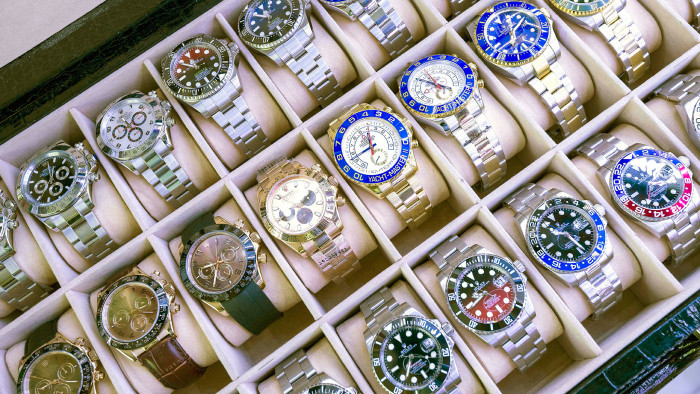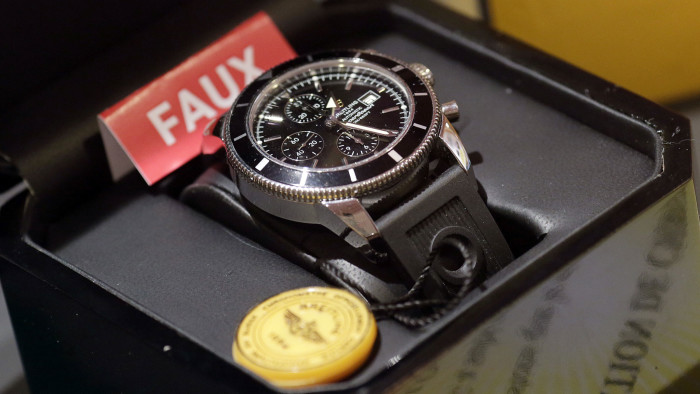Tech companies like Incopro and Netnames fight online counterfeits

Roula Khalaf, Editor of the FT, selects her favourite stories in this weekly newsletter.
In July, luxury brands won a significant victory in their battle with the billion-dollar online counterfeit industry. The Court of Appeal in London ruled that Richemont, owner of Cartier and many other prestigious labels, could ask internet service providers to block access to websites selling counterfeit goods. But Richemont did not build this case by itself: to detect those websites, Richemont had employed Incopro, an online brand protection service. The legal case related to eight websites including cartierloveonline.com, which was full of stolen brand imagery and was offering replica Cartier Love bracelets in white gold with four diamonds for £56. The real version costs £8,650.
Incopro uses a combination of techniques to target big offenders. These include sophisticated image-matching, where it scans for the false use of brand images and logos, and word searches such as “replica watch”. All the data are captured on a dashboard that brands can interact with and that presents clusters of sites linked by the same counterfeiters, allowing Incopro to target them in bulk.
By tracking the connections between those who advertise on Facebook and WeChat — a popular messaging service in China — and sell on marketplaces such as Taobao and Alibaba, Incopro can identify sellers of significant commercial size. That way, it can have a scalable impact. Once it has found the counterfeiter, it then targets sellers in one swoop: Incopro alerts online marketplaces, internet service providers and domain name registries and asks them to close the sites down, 24 hours a day.
You cannot fault the fraudsters for their chutzpah. One counterfeit watch website operating today purports to be a family-owned business with professional images of TAG Heuer and Breitling watches alongside its own blog, Twitter feed and Instagram page. It accepts PayPal and even has a bogus contact address and phone number. If discounts of up to 80 per cent do not ring alarm bells, coupled with the distinctly functional web experience — no close-ups of clasps and dials here — you could be fooled.
Many are fooled, or are seeking out counterfeits willingly. At Europe’s borders, watches are the most valuable type of fake good seized: €92m worth in 2014, according to the European Commission, with jewellery adding another €13m. But this is dwarfed by the US, where counterfeit watches and jewellery with a value of $582m were seized in 2015, up from $380m the year before. On one day in June 2015, 175,000 watches and related forgery tools were seized, worth a total of $100m.
While online counterfeits were once limited to rogue websites and auction platforms such as eBay, fraudsters are now selling through Alibaba, with its 434m active users. Social media and mobile apps now present the biggest challenges, as counterfeiters raise the profile for replicas by using paid searches on Google or popular hashtags on Instagram, for example. Seeing a cheap watch advertised on Facebook earns an element of trust with consumers who may therefore be more inclined to purchase.
“It is impossible to eliminate [brand infringement] completely,” says Stuart Fuller, director of commercial operations at Netnames, an online brand protection service whose clients include Danish jeweller Georg Jensen. “A counterfeiter will use every single digital marketing tool exactly the same as a genuine brand owner: paid search; social media; they will use apps; they will use all the tools a brand tries to drive traffic. The difference is [customers] might get a substandard product or nothing at all.”
“You want to hit all [a counterfeiter’s] operations in one go,” says Simon Baggs, an intellectual property lawyer at Wiggin and co-founder of Incopro. “He may have 100 shops on eBay and Amazon and Alibaba. So you add all these to the basket and send a notice at the end of the day. This way he wakes up in the morning and all his operations are gone. You really start to hit his business.
“For any substantial brand, the number of fakes can be vast,” he adds, estimating that a brand may typically have 3,000-5,000 sites selling counterfeit goods. “The best combination is legal enforcement and technology. You can’t do it all through litigation.”

At Incopro, a typical £100,000 campaign can reduce the volume of replicas on marketplaces such as Amazon or eBay by 60 per cent over six months, Mr Baggs says. An operation to track copies of a £1,000 dress, being offered at £125, removed 800,000 from those sites. He says 40 per cent of Incopro’s business comes from luxury companies.
Tiffany & Co is taking a different approach. It has developed its own mobile app for employees, called FakR, that allows them to report replicas by posting photos of street vendors hawking fakes or by sending links to questionable online auction listings. Internal reports have surged 60 per cent since it was launched last year and close to three-quarters of reports are actionable, says the company.
“The majority of time is now spent on digital enforcement, websites, social media,” says Ewa Abrams, associate general counsel at Tiffany. “The space of counterfeiting has evolved from bricks-and-mortar business and small operations to the online space. It requires brands to be a lot more flexible and try new things.”
The jeweller says its well-known designs require it to be “more vigilant” than most brands and it has an internal enforcement team as well as external contractors monitoring and tracking counterfeits online.
“There are legal avenues, albeit long ones,” says Ms Abrams, meaning, for example, the closing-down of rogue websites and their replacement with anti-counterfeiting messages on the domain name as part of an injunction. A website selling fakes at tiffany-focus.com was ordered to transfer the domain name as part of a permanent injunction in a US district court; the brand then replaced the site with details of the injunction. The monitoring and takedown process is “another tool in our arsenal”, Ms Abrams explains.
Industry bodies are adopting their own technological measures. Swiss watchmaker Bovet and luxury conglomerate LVMH are among brands looking to the Federation of the Swiss Watch Industry. It has a four-person team in Switzerland, alongside a handful of lawyers on call, that was established 10 years ago to prevent replica watches being sold on eBay and US site iOffer.com.
Carole Aubert, who heads the division, says it now has a “very large scope of activity”, which includes tracking about 80 platforms to delist items infringing trademarks; closing down rogue websites; and “trying to find the networks that hide behind these sites”.
“There is no definite solution,” says Ms Aubert, “so we have to be very imaginative.”
Comments